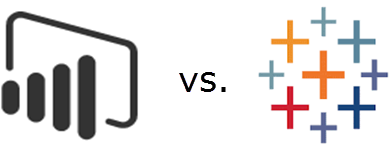Power BI vs. Tableau (Part 2)
In a previous blog, I reviewed the claims that Tableau made in their “10 Ways Power BI Falls Short” presentation. To be fair to Power BI, in this blog I’ll list 10 areas where I believe Tableau falls short compared to Power BI.
Overall
In this section, I’ll review some general implementation and cost considerations that in my opinion make Power BI more compelling choice than Tableau.
- Data Platform – No matter how good it is, a self-service visualization tool addresses only a small subset of data analytics needs. By contrast, Power BI is a part of the Microsoft Data Platform that allows you to implement versatile solutions and use Power BI as a presentation layer. Want to implement a real-time dashboard from data streams? Azure Stream Analytics and IoT integrates Power BI. What to show reports on the desktop from natural questions? Cortana lets you do it by typing questions or voice. Want to implement smart reports with predicted results? Power BI can integrate with Azure Machine Learning? Want to publish SSRS and Excel reports? Power BI supports this. Want to integrate your reports with Line of Business (LOB) applications? Integrate with them with PowerApps and Flow. Expect this strength to increase as Cortana Analytics Suite and prepackaged solutions evolve.
- Cloud First – I know that many of you might disagree here as on-premises data analytics is currently more common, but I see the cloud nature of Power BI as an advantage because allows Microsoft to push out new features much faster than the Tableau 2-year major release cadence. Recall that Power BI Service is updated on a weekly basis while Power BI Desktop is on a monthly release cadence. And because Power BI is a cloud service, it supports the versatile integration scenarios I mentioned before.
- Cost –Tableau states that it’s “among the most affordable business analytics platforms” but it’s hard to compete with free. Power BI Desktop is free, Power BI Mobile apps are free, Power BI Service is mostly free. If you need the Power BI Pro features, Power BI is packaged with the Office 365 E5 plan, it has an enterprise license, and I’ve heard customers get further discounts from Microsoft.
Next, I’ll review specific Power BI strengths for different user types.
Business Users
By “business users”, I’ll mean information workers that don’t have the skills or desire to create data models.
- Content packs and Get Data – Basic data analytics needs can be met in Power BI without modeling. For example, if the user is interested in analyzing data from Salesforce, the user can use the Salesforce content pack and get predefined reports and dashboards. Further, the user can create their own reports from the dataset included in the content pack.
- Productivity features – Power BI has several features that resonate very well with business users. Q&A allows users to ask natural questions, such as “sales last year by country”. Power BI interprets the question and shows the most suitable visualization which the user can change if needed. Within 20 seconds, Quick Insights applies machine learning algorithms that help business users perform root cause analysis and to get insights that aren’t easily discernible by slicing and dicing, such as to find why profit is significantly lower in December. Such productivity features are missing in Tableau.
Data Analysts
Data analysts (power users) are the primary audience for self-service BI. Power BI excels in the following areas:
- Data shaping and transformations – Source data is rarely clean. Excel Power Query and Power BI Desktop queries allow the data analysts to perform a variety of basic and advanced data transformations. Tableau assumes that data is clean or relies on tools from other vendors.
- Sophisticated data models – Power BI offers much more advanced modeling experience where a data analyst can build a self-service model on a par with semantic models implemented by BI pros. For example, the model can have multiple fact tables and conformed dimensions. Power BI supports one-to-many and many-to-many relationships. For the most part, Tableau is limited to a single dataset with limited “data blending” capabilities if you want to join to another dataset.
- Powerful programming language – Tableau’s formula language is nowhere near the Data Analysis Expressions (DAX).
BI and IT Pros
Besides the ability to integrate Power BI to implement synergistic solutions, pros can build hybrid solutions:
- Hybrid solutions – Want to get the best of both worlds: always on the latest visuals while leaving data on premises? Power BI lets you connect to your data on premises.
Developers
Developers has much to gain from the Power BI open extensible architecture.
- Extensibility – Power BI allow developers implement custom visuals which can be optionally shared to Power BI Visuals Gallery. By contrast, Tableau visuals are proprietary and not extensible. In general, the Power BI API are richer than Tableau’s. Power BI let developers push data into datasets for real-time dashboards and manipulate deployed objects programatically. Power BI Embedded, currently in preview, allows developers to embed interactive reports without requiring installation of tools and with very attractive licensing model.
Summary
To recap, Tableau is a fine tool but it will be increasingly harder for it to compete against Power BI.
Expect one or more of the following to happen to Tableau and other vendors within a year:
- Reduce drastically licensing cost
- Get acquired by a mega vendor
- Lose a significant market share
I often hear that Power BI is great but it’s not mature. In my opinion, you should view Power BI to be as mature as Tableau and other tools. That’s because the Power BI building blocks have been around for many years, including xVelocity (the in-memory data engine where imported data is stored), Power Query, Power Pivot, Power View, Tabular, and Azure cloud infrastructure.
I’d love to hear your feedback on Tableau vs. Power BI.





